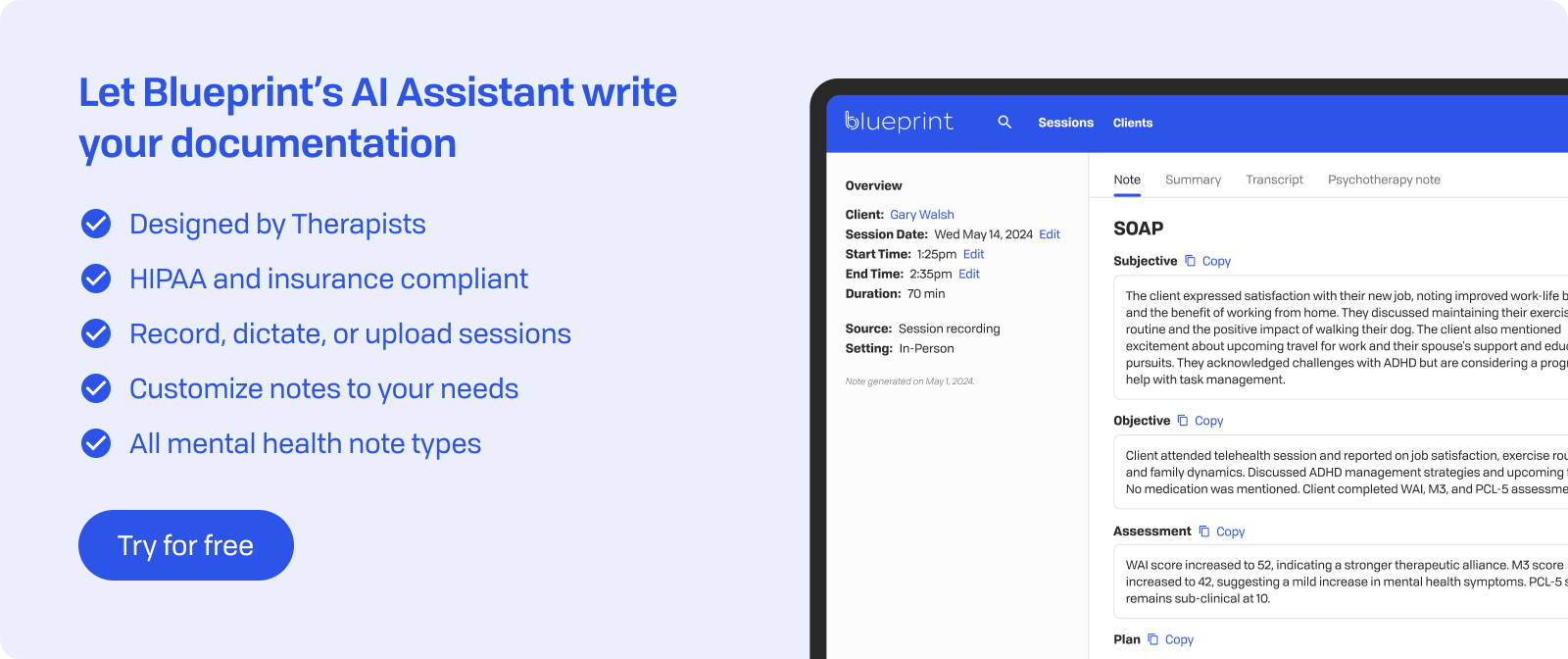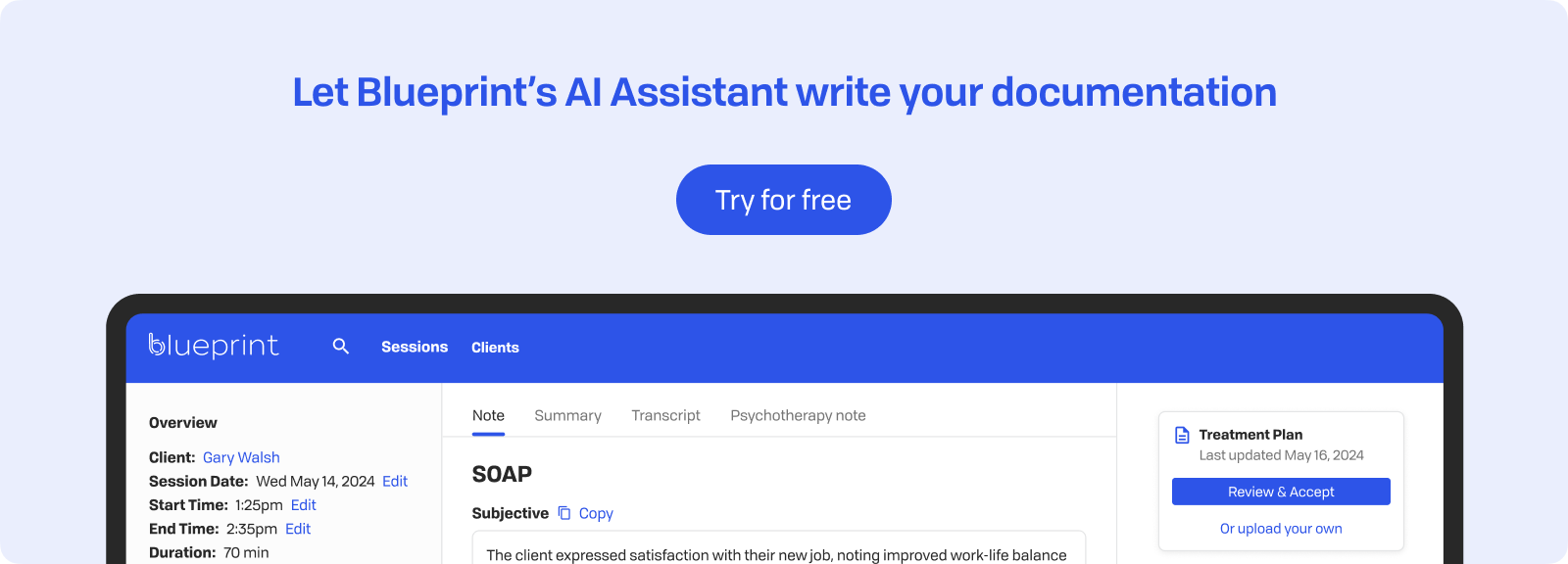In Brief
Building meaningful professional connections can greatly enhance your practice beyond just filling your schedule. The right referral relationships create benefits for everyone involved—you, your colleagues, and most importantly, the clients you serve.
Think about the last time you had a client whose needs fell outside your expertise. You might have felt the tension between wanting to help and the ethical obligation to refer them to someone who could serve them better.. Or perhaps you've been grateful when a colleague trusted you with their client's care.
These moments show why cultivating a strong therapist referral network matters. It's about creating a system where clients easily find the right fit, where your practice grows through trusted partnerships, and where professional isolation turns into collaborative support.
Clarifying What You Can Offer—and What You Need
Before reaching out to potential referral partners, take time to identify your unique clinical strengths and where collaboration would enhance your practice. This self-assessment forms the basis of authentic, reciprocal referral relationships.
Start by identifying your clinical strengths. Which client populations energize you and bring out your best therapeutic work? Maybe you excel with anxious teens, helping them navigate academic pressure and social challenges. Perhaps you've developed expertise in trauma recovery, confidently guiding clients through PTSD treatment using specialized approaches. Or you might thrive working with couples, skillfully navigating relationship dynamics and communication patterns.
Consider the techniques where you feel most competent and see consistent positive outcomes. Are you the therapist colleagues think of for EMDR? Do you have advanced training in DBT that sets you apart? Have you developed a reputation for your somatic approach to anxiety treatment? These specializations become your referral calling cards.
Equally important is recognizing where you need support. We all have clinical areas that challenge us or fall outside our training. Maybe you work primarily with adults but occasionally encounter adolescents who would benefit from someone with specialized youth experience. Perhaps substance abuse issues arise in your practice, but you lack the specific training to address them comprehensively.
This honest inventory serves multiple purposes. First, it helps you communicate clearly with potential referral partners about the clients you can best serve. Second, it identifies gaps where building relationships with specialists would strengthen your practice. Third, it positions you to make confident, appropriate referrals when clients need something beyond your scope.
Remember that acknowledging limitations isn't weakness—it’s ethical practice that prioritizes client welfare. When you know both your strengths and areas for growth, you can build a network that complements your work. This clarity turns referral conversations from vague networking into purposeful collaboration focused on optimal client care.

Finding and Connecting with Referral Partners
The best starting point for building your referral network is with colleagues you already know. Reach out to therapists in your area, whether they're from your graduate program, previous workplaces, or current practice setting. These existing relationships often turn into your strongest referral partnerships because trust is already established. Remember that the strongest networks are built on reciprocity; aim to be both a resource for referrals and a source of referrals for others.
Local organizations offer various networking opportunities:
- Community mental health centers: Connect with therapists serving different populations and specialties.
- Schools and universities: Build relationships with counselors who work with children, adolescents, and young adults.
- Medical practices: Partner with psychiatrists, primary care physicians, and other healthcare providers.
- Support groups and nonprofits: Meet therapists specializing in specific issues like grief, addiction, or trauma.
Professional development events offer natural networking opportunities. Conferences and workshops bring together therapists eager to learn and connect. Peer consultation groups provide ongoing relationship-building while enhancing clinical skills. Consider joining:
- State psychological or counseling associations: Regular meetings and annual conferences.
- Specialty-focused organizations: Groups centered on specific modalities or populations.
- Online continuing education events: Virtual workshops that include networking components.
Digital platforms help you reach beyond geographic boundaries. Online therapist directories allow you to search for specialists by location and expertise. Professional networking groups on social media facilitate connections and referral exchanges. Virtual peer consultation groups bring together therapists from different regions, enriching your network with diverse perspectives.
Participating consistently in these venues naturally leads to meaningful professional relationships that benefit your practice and your clients.

Establishing Trust and Clear Communication
Trust lays the groundwork for every successful referral relationship. Setting clear expectations around client needs, communication protocols, and follow-up procedures ensures that referrals work well for everyone involved while maintaining high ethical standards.
When making a referral, share key information while respecting confidentiality:
- Client's presenting concerns: Describe the primary issues and why you think this therapist would be a good match
- Treatment history: Include relevant therapeutic approaches tried and the client's response
- Referral rationale: Explain why you're referring (e.g., "Client could benefit from your EMDR expertise for trauma processing")
- Practical details: Mention scheduling preferences, insurance coverage, and any accessibility needs
- Your contact information: Be available for clarification if needed
Ask for appropriate information in return:
- Confirmation of receipt: Ensure the referral reached the intended therapist
- Availability updates: Find out if they can accept the client and approximate wait times
- General progress indicators: Without breaching confidentiality, understand if the therapeutic relationship is established
Set communication preferences early. Some therapists prefer email for non-urgent referrals, while others appreciate a brief phone call for complex cases. When making a referral, share key information while respecting confidentiality and using a secure, encrypted method of communication. Clarify how much follow-up communication is suitable—some prefer minimal contact to maintain clear boundaries, while others value periodic check-ins about the referral process itself.
Consistency helps build trust. Following through on promised referrals, respecting boundaries, and maintaining professional communication standards creates a reputation that encourages reciprocal referrals and strengthens your professional network.
Formalizing and Streamlining Your Referral Processes
Setting up systematic workflows turns referral exchanges into reliable professional processes rather than ad-hoc favors. Well-designed systems save time, reduce errors, and ensure clients receive appropriate care quickly.
Begin with standardized communications to streamline your referral process:
- Email templates: Develop versions for different scenarios—general referrals, urgent situations, and specific specialties.
- Referral forms: Create a simple document capturing important information: client demographics, presenting concerns, treatment history, and reasons for referral.
- Intake questionnaires: Prepare forms for receiving referrals that collect the information needed to assess suitability.
Before making any referral, check essential practical details:
- Credentials and licensure: Verify that the therapist holds the right licenses and specializations.
- Insurance panels: Confirm which insurance plans they accept to prevent financial surprises for clients.
- Current availability: Contact the therapist to ensure they're accepting new clients and check their typical wait time.
- Location and accessibility: Make sure their office location and setup meet the client's needs.
Think about using a tracking system to monitor your referral patterns. Simple spreadsheets can keep track of referral sources, outcomes, and reciprocal referrals received. This information helps you identify your most reliable referral partners and spot any gaps in your network.
Cloud-based documentation allows secure sharing of referral information while maintaining HIPAA compliance. Digital systems also enable quick updates when therapists' availability or specialties change, keeping your referral network current and effective.

Expanding and Sustaining Your Network
Being active in your professional community helps keep your referral network vibrant and growing. Changing up your involvement across different venues keeps things fresh and introduces you to new colleagues.
Consider these ways to boost your visibility:
- Community workshops: Present on your specialty areas or lead discussions on clinical challenges.
- Guest speaking: Share your expertise at local agencies, schools, or professional organizations.
- Peer luncheons: Host informal gatherings for therapists in your area to connect and exchange resources.
- Co-facilitated trainings: Team up with referral sources to offer complementary perspectives on treatment approaches.
Regular communication helps maintain strong referral relationships. Plan quarterly check-ins with your most active referral partners to share updates about your practice, new training you've completed, or changes in availability. These interactions can be informal—a quick email noting a successful referral outcome or expressing gratitude keeps connections warm.
Reciprocity strengthens sustainable networks. Keep track of the referrals you receive and look for opportunities to refer back when suitable matches arise. Beyond direct referrals, support your network through:
- Professional endorsements: Write recommendations or testimonials for trusted colleagues.
- Resource sharing: Forward relevant training opportunities or clinical resources.
- Collaborative care: When appropriate, coordinate treatment for shared clients.
- Joint initiatives: Co-host networking events or develop referral resources together.
Remember, maintaining your network takes intentional effort. Set reminders to reach out to referral partners, especially those you haven't contacted recently. Small gestures like acknowledging a colleague's professional achievement or sharing an article relevant to their specialty show you're committed to the relationship.
Navigating Ethical and Practical Considerations
Ethical referral practices protect both clients and your professional reputation. Maintaining client confidentiality remains a top priority throughout the referral process—share only what's necessary with explicit written consent. Document each referral decision in your clinical notes, including the rationale, options provided, and the client's informed choice.
Key ethical responsibilities include:
- Informed consent: Explain the reasons for the referral, provide multiple options when available, and ensure clients understand their right to decline.
- Competence boundaries: Recognize when client needs exceed your expertise and refer promptly rather than trying to treat outside your scope.
- Transparency: Clearly communicate any professional relationships with referral sources that might influence your recommendation.
- Documentation: Record referral discussions, client preferences, and the decision-making process in case notes.
Managing dual relationships requires extra care. When referring to close colleagues or friends, disclose the nature of your relationship and offer alternative options. Avoid financial arrangements that could create conflicts of interest. Do not engage in fee-splitting, which is the practice of accepting fees for referrals. Your agreements should always prioritize client welfare over financial gain..
Practical considerations help prevent ethical dilemmas:
- Multiple options: Provide at least 2-3 referral choices whenever possible.
- Clear boundaries: Maintain professional communication even with familiar colleagues.
- Follow-up protocols: Establish how you'll check on referral outcomes without breaching confidentiality.
- Written policies: Develop clear referral procedures for your practice.
Regular consultation with peers helps navigate complex referral situations. When uncertain about potential conflicts or ethical concerns, seeking supervision shows commitment to ethical practice and client welfare.

Key Takeaways
A well-developed therapist referral network offers lasting benefits beyond just exchanging client names. Your network can become a key part of sustainable practice growth while ensuring clients receive the most suitable care possible.
An effective referral network relies on several interconnected elements:
- Self-awareness: Knowing your clinical strengths and areas where collaboration can enhance care
- Strategic connections: Building relationships with therapists whose expertise complements your own
- Professional communication: Establishing trust through consistent, ethical referral practices
- Systematic processes: Creating workflows that make referrals efficient and reliable
- Active maintenance: Nurturing relationships through reciprocity and regular engagement
- Ethical integrity: Prioritizing client welfare while maintaining professional boundaries
Referral networks directly impact your practice's health. Referred clients often show stronger therapeutic engagement and longer treatment retention. Confidently referring clients whose needs exceed your expertise helps prevent burnout and maintains professional boundaries. Meanwhile, receiving appropriate referrals from trusted colleagues reduces marketing costs and builds your reputation within the professional community.
The most successful referral networks operate on principles of clarity, reciprocity, and ongoing engagement. Clear communication about your specialties and needs attracts appropriate referrals. Reciprocal relationships ensure mutual benefit and sustainability. Regular engagement keeps connections strong and referral pathways active.
Investing time in building your referral network pays off through improved client outcomes, enhanced professional satisfaction, and practice stability. Start with one meaningful connection and expand gradually—quality matters more than quantity in creating a network that truly serves your clients and supports your professional growth. Check out How to Get Referrals for more ways to boost your practice.

How Blueprint can help streamline your workflow
Blueprint is a HIPAA-compliant AI Assistant built with therapists, for the way therapists work. Trusted by over 50,000 clinicians, Blueprint automates progress notes, drafts smart treatment plans, and surfaces actionable insights before, during, and after every client session. That means saving about 5-10 hours each week — so you have more time to focus on what matters most to you.
Try your first five sessions of Blueprint for free. No credit card required, with a 60-day money-back guarantee.
























